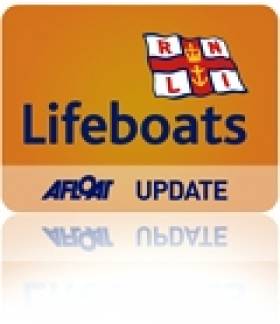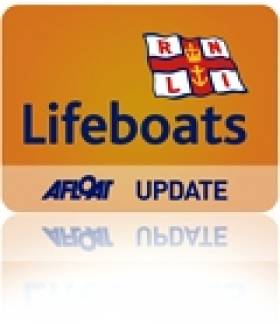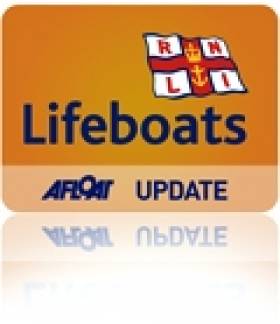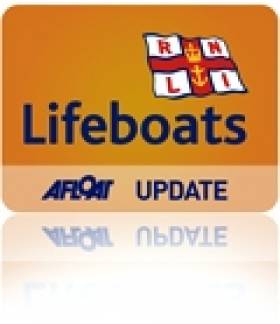Displaying items by tag: Lifeboats
Galway Lifeboat Rescues Two From Powerboat
#RNLI - Galway RNLI's lifeboat launched yesterday evening (Tuesday 8 September 2015) to rescue two people from a 25-foot powerboat that got into difficulty off Salthill on Galway Bay.
The cabin cruiser went aground west of Blackrock Tower at about 6.40pm as the tide was going out.
Galway's lifeboat crew launched at 7pm and, on arrival at the scene, two crew members disembarked and swam to the powerboat, where a father and son were still on board.
The lifeboat voluntreers then anchored the boat and escorted the two men safely to Blackrock. Much later that evening the lifeboat returned to the powerboat to refloat it at high water.
Galway RNLI helm David Oliver says the two people were not hurt in the incident. “They were new to boating and it was a lesson learned for them,” he says.
The volunteer lifeboat crew on this callout were Oliver, Dan King, Stephanie Carr and Ian O’Gorman.
Courtmacsherry Lifeboat In Callout To Swimmer Off Kinsale
#RNLI - The Courtmacsherry RNLI all-weather lifeboat was called out at 2.20am this morning (Monday 7 September) to go to the aid of a swimmer that had got into difficulty in a dangerous rip current off Garrettstown Strand near the Old Head of Kinsale in West Cork.
The lifeboat, under coxswain Sean O'Farrell and a crew of six, were away very quickly and proceeded at pace to the location of the incident. Also tasked were the coastguard unit from the Old Head of Kinsale and the Irish Coast Guard helicopter from Waterford, Rescue 117.
As the lifeboat arrived on scene within 15 minutes, under the cliffs off Garrettstown Strand, the crew used their searchlights to light up the area.
The swimmer got ashore and, with the assistance of the Old Head Coast Guard Unit, was transferred to the coastguard rescue vehicle until the HSE ambulance and Rescue 117 arrived. The casualty was then transferred by ambulance to Cork University Hospital.
It was a busy 12 hours for Courtmacsherry RNLI as earlier on Sunday evening (6 September) at 6.25pm, it was tasked by Valentia Coast Guard to go to an area where two kayakers were reported to be in difficulty off the Seven Heads in Courtmacsherry Bay.
A member of the public had reported the incident and again the lifeboat with a crew of seven were away in minutes.
They carried out an extensive search of the Seven Heads coastline and it was soon established that the kayakers had got ashore safely.
Speaking on the Strand in Garrettstown this morning, Courtmacsherry RNLI lifeboat operations manager Brian O'Dwyer said: "I want to say a hugh thanks to the fast response of the lifeboat crew and all the rescue services who rose from their beds quickly at 2.20am this morning to respond to a potentially very dangerous incident here off Garrettstown.
"We had enough for two volunteer lifeboat crews responding within minutes and great credit is due to these, who always respond immediately whether the call is by night or day and in all types of weather condition, when the lifeboat pagers alert them."
Arklow Lifeboat Aids Mussel Dredger Taking On Water
#RNLI - Following an alert by pager on Saturday afternoon (5 September), Arklow RNLI’s lifeboat Ger Tigchleaar was launched within minutes to the aid of the casualty vessel that was reported to be taking on water and at risk of sinking.
The volunteer lifeboat crew proceeded to the scene and after locating the fishing vessel 2.4km east of Mizen Head, it was established that the 44-metre mussel dredger was taking on large volumes of water, but was not in immediate risk of sinking as the vessel's own pumps were keeping it afloat.
The skipper of the mussel vessel requested the Arklow lifeboat to standby to assist should the situation worsen and escort the them back to Arklow Harbour.
Upon arrival back at Arklow, where all crew came ashore safely, the vessel was grounded on the slipway to prepare for repairs to be made. At this point the casualty vessel's pumps failed.
Immediately the Arklow lifeboats crew rendered assistance and put crew and a salvage pump aboard to help empty the hull of water. They assisted in stemming the ingress of water and making a temporary repair using one of the lifeboat crew's trademark yellow wellies as part of the temporary fix.
Speaking following the incident, Arklow RNLI volunteer lifeboat press officer Mark Corcoran said: “Thankfully the skipper of this vessel made the call for help early. When you are going to sea in any vessel always plan for the worst, always carry a means of calling for help and never hesitate in making the call to 999 or 112 or contacting the coastguard via marine VHF.:
Arklow RNLI’s volunteer lifeboat crew for this callout were Brendan Dillon, Michael Fitzgerald, Geoff Kearnes, Jimmy Myler, Eddie McElheron, Leigh Downey and Craig O’Reilly.
Tramore RNLI To Name New Lifeboat Next Weekend
#RNLI - The new Tramore RNLI D-class lifeboat D-781 will be officially named the Isabella Purchase during a ceremony at the National Lifeguard Training Centre in Tramore on Saturday 12 September at 3pm.
The lifeboat will be named during a short ceremony and service of dedication by Mrs Sally Mongey, wife of the late Finn Mongey. Finn was the lifeboat operations manager for Tramore RNLI Lifeboat Station from when it re-opened in 1964 until his retirement in 1984.
The lifeboat is being named in honour of Mrs Ivy Purchase, known as Isabella, who died in September 2012, leaving her estate to the RNLI to provide a lifeboat in her name. Isabella lived in Midhurst, West Sussex and was a long-time supporter of the charity.
This new lifeboat replaces the Trá Mhór, which was placed on service on 30 June 2005 and launched 127 times, rescuing 100 people over its lifetime.
Tramore RNLI lifeboat operations manager Derek Musgrave, who will be accepting the lifeboat on behalf of the Waterford lifeboat station, said: "On behalf of all the volunteers with Tramore RNLI I would like to express our sincere gratitude to the late Mrs Purchase for her generous and life-saving gift.
"This lifeboat is the vessel that will carry our volunteer lifeboat crew out to sea to save lives and onboard it, our volunteer lifeboat crew will learn and develop their skills through extensive training.
"We look forward to welcoming the people of Tramore, who have been so generous in their support to the RNLI and our lifeboat station, to show them the newest edition to the life-saving fleet in Ireland."
The D-class lifeboat is built at a cost of €62,000 and has been the workhouse of the charity for nearly 50 years. It is inflatable, robust and highly manoeuvrable, capable of operating much closer to the shore than the all-weather lifeboats.
It is especially suited to surf, shallow water and confined locations, often close to cliffs, among rocks or even caves. It measures five metres in length and can carry three crewmembers onboard. It has an endurance of three hours at sea, at its maximum speed of 25 knots.
All are welcome to attend the naming ceremony and service of dedication. Please note that the Totem Pole car park located at the end of the Lower Promenade along the seafront will be closed to facilitate the ceremony from 9am to 5pm on the day. An alternative car park located adjacent to this will remain open to the public and can be accessed by Estuary Road. Alternative parking will also be available along the Main Promenade.
Baltimore Lifeboat In Medevac From Cape Clear Island
#RNLI - Baltimore RNLI's lifeboat was launched at 11.38pm last night (Saturday 11 July) to convey a sick teenager from Cape Clear Island to Baltimore.
The teen, who was suffering from an appendicitis, was transferred from the island aboard the lifeboat Alan Massey to Baltimore Lifeboat Station, from where an ambulance brought her to hospital in Cork.
Equipment was then cleaned and stored, and the lifeboat was ready for service again by 1.10am.
The crew were Kieran Cotter, Pat Collins, Jerry Smith, Don O'Donovan, Colin Whooley, Sean McCarthy and Mícheál Cottrell. Shore helpers at the station were Brian McSweeney, Aidan Bushe and Youen Jacob.
#RNLI - The volunteer lifeboat crew at Portaferry RNLI were called out yesterday evening (Thursday 9 July) in response to a call to the emergency services.
A member of the public had reported that a small sailing boat, a Topper with two people on board, appeared to be in difficulty in the vicinity of Don O’Neill Island near Killyleagh, Co Down.
The volunteer crew of the Portaferry lifeboat were paged just before 7.00pm and the RNLI lifeboat, an inshore Atlantic 85, was launched at 7.07pm. At the time the weather was fine with good visibility, a gentle swell and slight breeze.
The RNLI crew arrived on scene at 7.12pm where the two sailors, an adult woman and a teenage boy, had taken the small sailing boat out of the water on to the island where they were waiting for the tide to turn. Both were unharmed and properly equipped wearing lifejackets and wetsuits.
As the wind was starting to pick up strength, the two sailors agreed to return to Portaferry Marina with the volunteer RNLI crew and were subsequently taken onboard the lifeboat with their small boat before being safely put ashore at the marina at 7.38pm.
Arklow, Howth Lifeboats Aid Stricken Sailing Vessels
#RNLI - Following a lifeboat pager alert at 1.18pm yesterday afternoon (Thursday 9 July), Arklow RNLI's volunteer crew launched to a stricken sailing vessel.
Within minutes of the alert, the lifeboat Ger Tigchleaar was en route from Arklow Harbour in good weather and slack winds to the casualty boat, a local sailing yacht about 1.5 miles north. The vessel, with two crew onboard, had suffered engine failure.
Under the direction of coxswain Ned Dillon, the lifeboat crew – Michael Fitzgerald, Andrew Loughlin, Jimmy Myler and Leigh Downey – secured a tow line to the vessel and brought her and her crew back safely to Arklow Harbour, bringing her alongside at the inner dock marina pontoons.
Speaking following the callout, Arklow RNLI volunteer press officer Mark Corcoran said: "Even very experienced sailors can get into difficulty. If you’re going out on the sea, be prepared and plan for the worst and always have a means of calling for help. Always respect the water."
Howth RNLI had a trickier callout to deal with three days earlier after a sailing yacht beached on rocks at Lambay Island.
The lifeboat was on scene and located the casualty vessel just before 11.00am on Monday 6 July. Volunteer lifeboat crew Ian Martin and Ian Sheridan launched their small XP inflatable boat and went ashore to investigate in poor weather conditions, with the win gusting to 58 knots and a rough sea state.
Two men were located aboard and the decision was made by lifeboat coxswain Fred Connolly to request the coastguard helicopter to lift the casualties to safety as the sea was too rough to risk a transfer to the all-weather lifeboat using the XP inflatable.
The two men were airlifted to safety and the lifeboat returned to station in what was described by the volunteer crew as "challenging conditions".
#RNLI - Skerries RNLI volunteers launched for their third callout within seven days yesterday (Saturday 04 July) following reports of a kayaker in distress off Gormanston beach.
The pagers sounded shortly after 11.30am this morning, with the lifeboat – launched with volunteer Joe May at the helm and crewed by volunteers Emma Wilson and Paddy Dillon – proceeding directly to Gormanston.
Once on scene it was established that the casualty had abandoned his vessel and his belongings and swam to shore. The crew located an inflatable kayak nearby and recovered it onto the boat to prevent any hazard to other vessels. Conditions at the time were fair with a Force 3-4 northerly wind.
On the previous Thursday evening (2 July), while on a scheduled training exercise, Skerries RNLI were tasked by Dublin Coast Guard to investigate reports of a personal water craft in difficulty near Colt Island in Skerries.
The lifeboat was on scene very quickly as they were on exercise in the area. They located the casualty and took him on board the lifeboat, towing his vessel to the safety of Skerries Harbour. After a routine assessment he was deemed to require no further assistance.
Four days before that, Skerries RNLI brought four people to safety after their racing yacht was holed when they struck rocks near Colt Island, as previously reported on Afloat.ie.
Wicklow Lifeboat Rescues Jetskier After Engine Cuts Out
#RNLI - Wicklow RNLI's inshore lifeboat launched at 2.25pm yesterday afternoon (Friday 3 July) to assist a jetskier north of the harbour.
The jetskier had set off from Wicklow and was about a half mile offshore when the engine cut out, leaving him adrift and unable to get ashore.
Within minutes of launching, the lifeboat reached the casualty, who was then taken on board with his jetski in tow back to Wicklow Harbour.
The inshore crew on this callout were helm Dave O'Leary, Lisa O'Leary and Carol Flahive.
#RNLI - The RNLI will have a fully operational lifeboat station in Belfast City from 9am tomorrow 2 July right through to Sunday evening 5 July for the Tall Ships Races.
With up to 750,000 visitors expected in Belfast over the next four days, a number of volunteers from Bangor and Red Bay lifeboat stations will be on call to provide a 24-hour search and rescue service during the event.
The crew will operate from a temporary lifeboat station located in Belfast Harbour Marina and will respond to any emergency on Belfast Lough using an Atlantic 85 relief lifeboat.
During the Tall Ships Parade on Sunday, both the Atlantic 85 lifeboat and an all-weather Trent class lifeboat crewed by Donaghadee RNLI will be operational on Belfast Lough for search and rescue capabilities.
Speaking ahead of the Tall Ships Races, RNLI divisional operations manager Darren Byers said: "For the duration of the weekend and specifically to accommodate the large numbers expected to descend on Belfast to watch the Tall Ships spectacle, the RNLI will be fully operational at the heart of where all the activities will be taking place.
"Belfast RNLI will operate for four days only supported by its nearest lifeboat stations at Bangor and Larne. This means should there be an emergency during the event, we can reduce the time it takes to get on scene while maintaining a business as usual operation at our flank lifeboat stations."
The RNLI will have a significant presence on site throughout the weekend and has been honoured to be chosen by Tall Ships Belfast as one of five key maritime charities to benefit.
As well as a fully operational lifeboat station, the RNLI will have an all-weather Trent class lifeboat afloat which can be viewed from the quayside at Belfast Harbour Marina. Volunteer lifeboat crew will be on hand to answer any questions and to demonstrate how they use the lifeboat for search and rescue.
RNLI lifeguards who patrol 10 beaches in Northern Ireland during the summer season will also be displaying the rescue water craft and lifesaving kit they use.
Visitors to the RNLI areas can also take part in the ‘Get Your Kit on Challenge’. This is a timed challenge that pits members of the public against the clock to see how long it takes them to put on an inshore lifeboat crew member’s full kit: dry suit with yellow wellies, lifejacket with crotch straps and helmet. The lifeboat crew do this in seconds as they race to launch the lifeboat on a callout.
RNLI community fundraising manager Nicola Kelly is looking forward to the event. "The RNLI is hosting a variety of engaging activities at Tall Ships Belfast and we are honoured to have been selected as one of the official charities to benefit," she said.
"We are looking forward to welcoming visitors to the RNLI areas and hope that in doing so we can provide an entertaining, informative and interesting aspect to the full programme being provided.
"As well as saving lives at sea and on inland waters, the RNLI also provides education along with sea safety advice and demonstrations and we hope spectators can sample a flavour of that this weekend."



































































